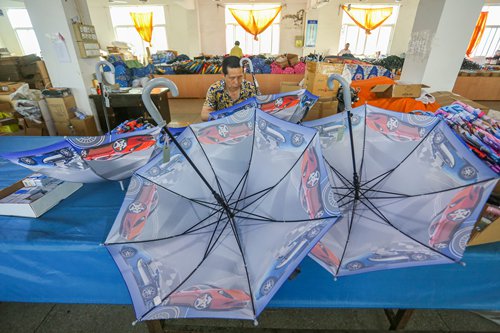
A Chinese worker makes umbrellas at a factory in Jinjiang, East China's Fujian Province on June 23, 2017. (Photo: IC)
Some 38 years ago, Ding Hemu sold all his valuable belongings and gathered 1,000 yuan ($150) to start a small shoe-making workshop, hoping to feed his family.
Now, Ding has made his small family business into a sportswear empire famous around the world. He has also become an icon in Jinjiang, now a small coastal city in East China's Fujian Province.
ANTA, which was set up by Ding in 1991, is now China's most valuable sports brand with a market value of more than 100 billion Hong Kong dollars ($12.7 billion), making it the third in the industry globally in terms of market value, after Nike and Adidas.
Ding is just one of the city's thousands of entrepreneurs who have helped transform the previously poor county in the late 1970s into a role model.
Covering just one two-hundredth of Fujian's area, Jinjiang created over 6 percent of the province's GDP in 2017. It has 46 listed companies and 50,000 private enterprises.
Over the past four decades, the city has developed an economic model focusing on the real economy and private enterprises, nurturing a number of famous brands including China's largest tissue paper manufacturer, Hengan Group and sportswear giants ANTA, Xtep and Septwolves. One in five pairs of sports shoes in the world is produced in Jinjiang.
The path of economic development with a market-led and export-oriented economy and a booming private manufacturing sector, has been called the "Jinjiang Model."
Focusing on the real economy
As a local proverb goes, "barren land might not produce good crops but gold." It was poverty that forced Jinjiang people to change.
"Only by setting up your own business can your family live a good life," said Hong Zhaoming, who set up his clothing workshop in 1984 at Yinglin village after peddling fruit, pork, fertilizer and rice for years. He later created K-Boxing, a top jacket brand in China.
Since China's reform and opening-up in 1978, merchants from Jinjiang have made use of the city's geographic advantage to sell goods from overseas to other parts of China.
In the early years of opening-up, setting up business needed courage not only from entrepreneurs, but also from local governments. The Jinjiang government gave the green light to private financing and to use market-based pricing, making Jinjiang a pioneer of China's rural industrialization.
In 1984, Chendai township, where most of Jinjiang's private enterprises were located, became the first township in the province to have a total industrial and agricultural output of over 100 million yuan. In the same year, Jinjiang welcomed the first batch of foreign investors, many of whom were overseas Chinese with Jinjiang as their ancestral home.
In 1994, the number of foreign-funded enterprises reached 1,000, with a total production value of more than 8 billion yuan.
In 2005, ANTA set up China's first high-tech sports science lab. It has also set up design centers in the US, Japan and the South Korea, achieving Jinjiang manufacturers' ambitions of going global.
"We don't want to be China's Nike, but the world's ANTA," said its chairman and CEO Ding Shizhong, who is eyeing a dominant role in the Chinese market with an expected yearly revenue of more than 100 billion yuan by 2025.
In spite of rising labor costs, market competition and the lure of making fast money in the capital market, entrepreneurs in Jinjiang still focus on their traditional products: shoes, jackets, paper, sweets and umbrellas.
"Their insistence on the real economy and continuous efforts in innovation to make products better and smarter are the keys to Jinjiang's success," said Gao Ming, the professor with Fuzhou University.


